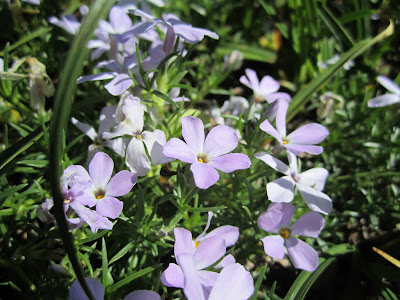

We can’t believe we hadn’t done this hike before. We thought about the Chain Lakes hike but it still had too much snow, so we were advised to try the Skyline Divide hike. A great recommendation. We hiked 10 miles round trip starting from the trailhead (parking lot on FR 37) in about 6.5 hours with two stops to eat and lots of stopping to enjoy the flowers and vistas. The trailhead is at 4,300 feet and the highest we hit was about 6,560 feet on Chowder Ridge. Skyline Divide connects up to Chowder Ridge as shown below (taken from reference [1]).
From talking to various folks we learned that it has been a late summer up on Skyline Divide. That meant a little bit of snow to walk over or around, but not that much. Today it was 60-65F and wildflowers were out en masse. Before we get to the bulk of photos let’s address a few basics we wondered about before and during the hike:
· What is Mt Baker named for? Mt Baker was named by George Vancouver who named it after his 3rd Lieutenant Joseph Baker of the HMS Discovery, who first saw the mountain on April 30, 1792 as described in Vancouver’s Discovery of Puget Sound [p. 82]
· Why is it called Chowder Ridge? From the Taylor and Douglas 1978 paper, Chowder Ridge is made up of sedimentary rock and the marine fossils sometimes found in the rock on the ridge are responsible for the name “Chowder Ridge.” This ridge is a special place in that it has several contrasting habitats in one area: steep, dry, southerly slopes and cool, snowy, steep north slopes. The former habitat is similar to the eastern Cascades and the northern Rockies. The latter habitat is characteristic of the western Northern Cascades.
· What’s a krummholz? A krummholz is a contorted often stunted subarctic or subalpine tree. The physical aspects of krummholz trees are formed by the severe conditions they grow in.
· Is that red snow I see? Why is snow red? According to Colored Snow Chemistry an article on About.com, the red snow is caused by the growth of algae and one in particular called Chlamydomonas nivalis. Sometimes the red snow is called watermelon snow and has a sweet-scent. (We did not go up and smell it to verify that!) The pigment causing the red color is red carotenoid , astaxanthin. Astaxanthin is found also in salmon, shrimp and providing the red color of salmon meat and cooked shellfish. This is “Chowder Ridge” after all.
A list of useful resources used to create this post is given below the images. In regard to references, we have to say that it’s been a struggle navigating all the different information sources in regard to naming. Years ago, a friend scolded us to stop using common names and use the established binomial nomenclature to ensure being understood. So, we did. Well that same friend came over recently and lamented about the unstable naming in the orchid world. And we find a bit of that when consulting different references for flowers we saw on Skyline Divide. At most we can say the genus with some degree of certainty. It makes you start to wonder if common names are not so bad after all.
Valerian sitchensis - Sitka Valerian

Phlox diffusa

Potentilla flabellifolia

Penstemon procerus

Skyline Divide Meadow

Skyline Divide Meadow

Achillea millefolium

Lupinus latifolius - Lupine

Erigeron peregrinus

Polygonum bistortoides - American Bistort

Claytonia lanceolata - Spring Beauty

Euphydryas anicia - Anicia Checkerspot

View of Mt Baker from Skyline Divide

Solidago multiradiata - Northern Goldenrod (?)

Penstemon davidsonii - Davidson's Penstemon
A very small leaved plant with oversized flowers.

Phyllodoce empetriformis - Pink Mountain Heather

Erythronium grandiflorum – Yellow Glacier Lily

Pedicularis racemosa

Luetkea pectinata - Patridgefoot (Rose family)

Eriogonum umbellatum - Sulfur Buckwheat Blossom

Castilleja parviflora (white)

Sedum lanceolatum

Sedum lanceolatum - in bloom

Saxifraga

Saxifraga bronchialis

Chowder Ridge Leading Looking to Mt Baker

Chowder Ridge Edge

Papilio zelicaon – Anise Swallowtail

Eriogonum (or Buckwheat) of some sort. Eriogonum umbellatum or a subspecies?

Mt Baker Backdrop. Chowder Ridge

The Classic Blue Layers Northwest View from Chowder Ridge

Dasiphora floribunda - Shrubby Cinquefoil. Syn. Potentilla fruticosa

Lupinus lepidus var. lobbii – Dwarf Lupine on Scree

Icaricia icarioides - Boisduval's blue

Pedicularis bracteosa – Towering or Fernleaf Lousewort

Clintonia uniflora - Queen's Cup. (Lily family)

Heracleum lanatum - Cow Parsley – Trailhead

Resources Used in this Post:
1. Plants of the Pacific Northwest Coast: Washington, Oregon, British Columbia and Alaska
We’ve had the book for a while and not until now did we realize how handy this book is. In particular, the notes sections of each plant is what is useful, giving a little history, a little folklore, a little about the etymology, or related plants. It makes the book especially useful, yet, it is a good, compact guide.
2. The Washington Trails Association articles on Spotting Butterflies: How, when and where to find Lepidoptera in the Cascades and Olympics.
A quick and easy read to help you figure out the most common butterflies you will see.
3. Washington Native Plant Society
4. Turner Photographics Pacific Northwest Wildflowers
You can look up plants by family, genus, color or flower type. Handy.
5. Taylor and Douglas’s 1978 paper Plant Ecology and Natural History of Chowder Ridge, Mt. Baker: A Potential Alpine Research Natural Area in the Western North Cascades
6. Burke Museum’s University of Washington Herbarium (WTU) Online Collection
7. Colored Snow Chemistry article on About.com
8. Vancouver’s Discovery of Puget Sound
9. Wild Flowers West
Sites like this make it easier to figure out what plant you saw.

No comments:
Post a Comment
All comments go through a moderation process. Even though it may not look like the comment was accepted, it probably was. Check back in a day if you asked a question. Thanks!